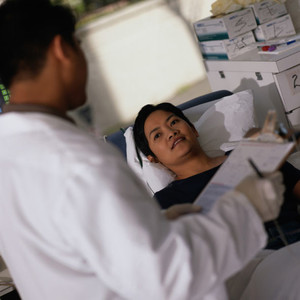The first filgrastim biosimilar was approved in Europe in 2008, prompting Dr Pere Gascón and co-authors to review the evidence relating to the efficacy and safety of biosimilar Zarzio (filgrastim) and Filgrastim Hexal (filgrastim) since that time. The authors report a pooled analysis of post-approval studies of Zarzio (Sandoz) used for the prevention of neutropenia in patients with cancer who are undergoing cytotoxic chemotherapy [1].
Several concerns have arisen over the use of biosimilars in the clinic, and data on each of these – product quality, efficacy, immunogenicity, safety, labelling, traceability, automatic substitution and extrapolation to other indications – is reviewed in the paper.
In general, the quality of biosimilars compares favourably with their originators. In the case of Zarzio, protein structure, mass, size, charge and hydrophobicity were shown to be identical to the originator biological, Neupogen (Amgen). Similarly, Zarzio has shown comparable bioactivity as indicated by binding to the granulocyte colony-stimulating factor (G-CSF) receptor. The bioequivalence of the biosimilar and its originator was confirmed in four comparative phase I studies, in which absolute neutrophil count and CD34+ cell count were used as surrogate markers of efficacy.
Nevertheless, concerns remain over whether biosimilars are effective in the real world clinical practice setting. To address this, Gascón and co-authors ran an analysis of pooled data from five post-approval studies where Zarzio was used for the prophylaxis of chemotherapy-induced neutropenia in cancer patients. As a result, they found that Zarzio appears effective for the prevention of this side effect in clinical practice across a variety of cancers.
With safety in mind, and particularly the potential for a different immunological response to that seen with the originator, the authors found no striking or new safety signals for Zarzio following an estimated exposure to this biosimilar of approximately 4.5 million patient days (as of June 2013, according to Sandoz [data on file]).
The authors conclude that an increasing body of clinical evidence appears to rule out initial concerns about the efficacy and safety of biosimilar G-CSFs. The European Organisation for Research and Treatment of Cancer (EORTC) now recognizes these biosimilars as an alternative to the originator. The uptake of biosimilars will grow as the cost benefits become clear [2, 3], but it is vital that strict pharmacovigilance and data monitoring continue to examine the long-term efficacy and safety of biosimilars.
Conflict of interest
Several of the authors of the research paper [1] reported conflicts of interest, including having received honoraria from Sandoz for speaking at educational events, congress presentations and attending advisory boards. For more details see [1].
Editor’s comment
Readers interested to learn more about possible how the safety and toxicity of biosimilars are assessed in the EU and the US are invited to visit www.gabi-journal.net to view the following manuscript published in GaBI Journal:
Safety and toxicity of biosimilars—EU versus US regulation
If you are interested in contributing a research paper in a similar area to GaBI Journal, please send us your submission here.
References
1. Gascón P, et al. Clinical experience with Zarzio® in Europe: what have we learned? Support Care Cancer. 2013;21(10):2925-32.
2. GaBI Online - Generics and Biosimilars Initiative. Biosimilar G-CSF prescribed more than originator [www.gabionline.net]. Mol, Belgium: Pro Pharma Communications International; [cited 2014 Mar 14]. Available from: http://www.gabionline.net/Biosimilars/News/Biosimilar-G-CSF-prescribed-more-than-originator
3. Olry de Labry A, et al. Biosimilars in the European market. Generics and Biosimilars Initiative Journal (GaBI Journal) 2013;2(1):30-5. doi: 10.5639/gabij.2013.0201.012
Permission granted to reproduce for personal and non-commercial use only. All other reproduction, copy or reprinting of all or part of any ‘Content’ found on this website is strictly prohibited without the prior consent of the publisher. Contact the publisher to obtain permission before redistributing.
Copyright – Unless otherwise stated all contents of this website are © 2014 Pro Pharma Communications International. All Rights Reserved.








 0
0











Post your comment